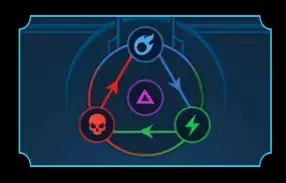In Raid: Shadow Legends, winning battles transcends merely assembling a powerful team—it's about mastering the nuanced mechanics that dictate combat effectiveness. Central to this is the Affinity System, which plays a pivotal role in determining how your Champions fare against opponents. Affinities affect not just damage output but also critical hit rates and the success rate of applying debuffs. By leveraging the strengths and mitigating the weaknesses of each Affinity, you can gain a crucial tactical edge in battles across Arena matches, Dungeons, Clan Boss encounters, and Campaign stages.
This comprehensive guide delves into each Affinity, providing you with the knowledge to effectively harness this system to elevate your team's performance. If you're new to the game, don't miss our Beginner’s Guide for Raid: Shadow Legends for a thorough introduction to the game!
Understanding Affinities in Detail
1. Magic Affinity (Blue)
Champions endowed with the Magic Affinity often excel as potent attackers or well-rounded support units. They are adept at dealing damage and perform reliably across various game modes. Magic Champions particularly shine against Force Affinity foes, making them invaluable in specific Arena encounters and certain dungeon stages like the Ice Golem’s Peak.
Strong against: Force (Red) Affinity
Weak against: Spirit (Green) Affinity
Best uses: Dungeons (Force-heavy), Arena offense/defense against Force teams.
2. Spirit Affinity (Green)
Spirit Affinity Champions are typically the backbone of teams, offering utility through healing, buffs, or crowd control. They thrive when pitted against Magic Affinity enemies, making them essential in Magic-heavy dungeons like Dragon’s Lair and certain Faction Wars scenarios.
Strong against: Magic (Blue) Affinity
Weak against: Force (Red) Affinity
Best uses: Magic-heavy dungeons (Dragon’s Lair), Arena control teams, support roles in PvE scenarios.
3. Force Affinity (Red)
Force Champions often serve as defensive stalwarts or crowd-control experts. They usually boast higher defensive stats or possess unique abilities that can disrupt enemy strategies, proving crucial in both Arena defense and challenging PvE content. Force Affinity is especially effective against Spirit Affinity Champions.
Strong against: Spirit (Green) Affinity
Weak against: Magic (Blue) Affinity
Best uses: Arena defense, Spider’s Den dungeon, Clan Boss compositions, high-defense PvE teams.
4. Void Affinity (Purple)
Void Affinity Champions stand out for their neutrality, having no inherent strengths or weaknesses against other Affinities. This versatility and consistency make them invaluable across all game modes, particularly in high-level content such as Clan Boss, Doom Tower, and Faction Wars, where predictability is key.
Neutral: No affinity strengths or weaknesses
Best uses: All game modes, especially Clan Boss, Doom Tower, and PvP Arena due to consistent performance.

Common Affinity Mistakes to Avoid
Ignoring Affinity Dynamics: Simply stacking your strongest Champions without considering Affinity matchups can lead to unexpected defeats.
Over-Relying on One Affinity: An unbalanced Affinity team exposes you to severe weaknesses. Diversifying your team ensures greater flexibility.
Underestimating Void Champions: Many players overlook Void Champions due to their rarity, but their Affinity neutrality offers unmatched versatility, especially in late-game scenarios.
The Affinity system in Raid: Shadow Legends is more than just a mechanic—it's the strategic foundation that can determine victory or defeat. A deep understanding of each Affinity's strengths and weaknesses enables you to make informed tactical decisions, construct optimal teams, and excel in all game modes. Whether you're tackling high-level content in Dungeons, climbing the Arena rankings, or consistently performing against the Clan Boss, mastering Affinity matchups can significantly enhance your gameplay.
For an enhanced gaming experience with smoother gameplay, improved precision, and easier team management, consider playing Raid: Shadow Legends on PC with BlueStacks.






